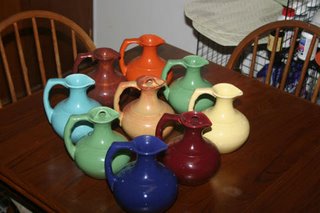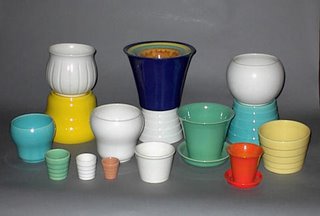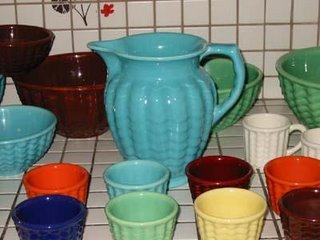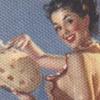Thursday, January 18, 2007
 It's not easy being Green
It's not easy being GreenWorld hunger, nuclear arms, terrorist attacks, foreign wars, global warming, clones, animal rights, and religious events are all important issues, but nothing goes to the head of the class for Franciscan buffs like the ongoing disucssion about the GREENS.
Green has been identified by the photographic film makers as having the most variations on the color spectrum and being the hardest of all the colors to reproduce correctly. For the Franciscan factory, green has proved equally challenging.
Collectors want the best examples of any piece they can find, and as many distinct variations in color as possible, so knowing what glazes were used for any particular form is very important. Slight tone variations due to batch are expected, but often, the color variations are signifigant enough that questions arise.
Is the creamer being offered on line a "lettuce" color or an "artware" tone that is not normally used on the piece? Does the photograph do the item justice, or is that picture washing out the real color of the piece?
What our group has found is that the original names of the colors used for each distinct line are not the beginning and end of the issue. Specialty pieces were made in colors not originally intended. Some items were glazed with tones not documented. And what one person calls "bright green" might well be a medium tone compared to what the company called it's 'brightest' green.
While some colors were universally used across all the various lines, some colors were specific only to one type of pottery or artware. Here is a "short version of the color Green.

ElPatio, the first of the dinnerware lines, was in production longer than any other, and the colors possible are uncountable.
We have James's book to thank for most of the basic information.
This full set on the left (photo one) is apparently a wonderful rendition of the APPLE GREEN color.
The egg cups (below) show several colors including the Apple Green in the first position.

EP came originally in Dark Green Gloss (MP4) in 1934-35, Apple Green (MP18) 1939-1942, Chartreuse Satin (MP45) 1942-1950, Bright Green (MP 78) 1948-1950. We have seen the "Bright green" commonly referred to as "Lettuce Green" often enough to become almost interchangeable when speaking with collectors.
One of the GREAT collectors in California, Gabriel, has a wonderful web page with a very nice section on the "green" issue at:http://tinyurl.com/2ezxa4
In this EP carafe and cup set, the "Bright Green" is on the left, the "Apple Green" on the right.Often, unless held up next to each other, telling one green apart from another is nigh on impossible.
This Table shows the versitility of the solid EP colors when mixed with other GMcB dinnerware.
EP plates in the Apple Green Tone.
Coffee Jugs in the Apple Green shade.
EP jugs in a variant shade of green.

A Classic dinner table in the magnificent Dark Gloss Green tone.
This is an unusual MATT Green finish on this EP pitcher.
A wonderfully lit photo of El Patio and it's color variety.
After The EP Line, anything else seems relatively easy to diagnose in the glazes.
The Cocinero custard cup is Apple Green.
"Apple" green was one of the 4 original colors this line came in, and "Apple" was the only shade of green that the line was officially glazed in. The line existed for 4 years, from 1935-1938.
 The Tropico Artware line was created the same year that El Patio dinnerware was born, and was designed for both home gardening as well as floral use.
The Tropico Artware line was created the same year that El Patio dinnerware was born, and was designed for both home gardening as well as floral use.Colors included Apple Green , Verde Green, Green, Matt Green, & Gloss Green.
The Flower pot just right of center (with saucer) is Gloss Green.

Montecito duotone in an unusual Satin Green exterior. Original colors included Celadone Green (MP 24), Green (MP62), and the Satin (MP3).

Saguaro Artware came in the Satin Green (MP62) and a Satin Chartreuse (MP45).

Reseda C-464 Tall Footed Green Vase in the Verde Green (MP 68).
Nasco Greens are also unique to the piece.


There are special Greens that will never be duplicated, such as the King Saud dinnerware. Made specifically for the Saudi Royal Family, it included pieces for an entire whole roasted elk to be served at a banquet.

The set was made to "perfection" specifications, with delivered pieces to be *perfect* in every way. This meant that there were many firings and duplicates created when the first pieces came out less than perfect.
 ALL pieces not perfect and ready for delivery were to be destroyed. We have these examples due to the diligence of staff that kept these 2 pieces rather than destroy them. We have spent hours looking at them and never did find what the flaw was on these.
ALL pieces not perfect and ready for delivery were to be destroyed. We have these examples due to the diligence of staff that kept these 2 pieces rather than destroy them. We have spent hours looking at them and never did find what the flaw was on these. The colors are a special green, and Gold- 24 carat gold.
The colors are a special green, and Gold- 24 carat gold. Thank You
<< Home


